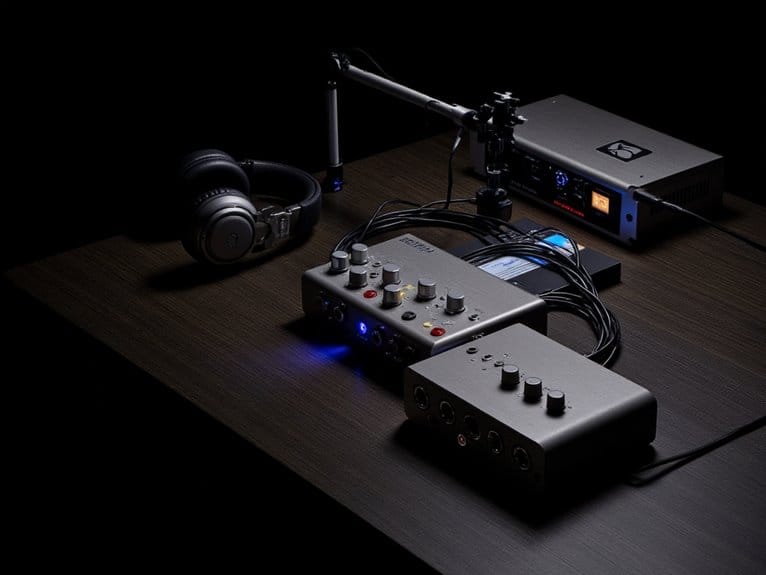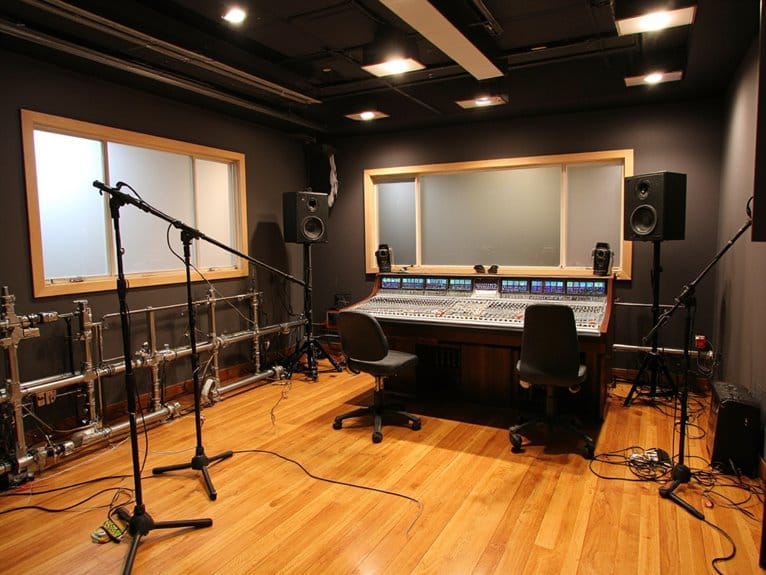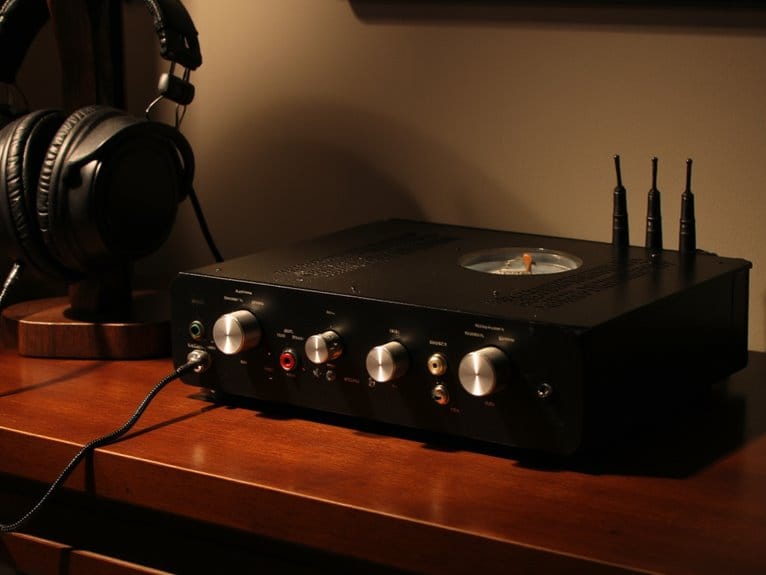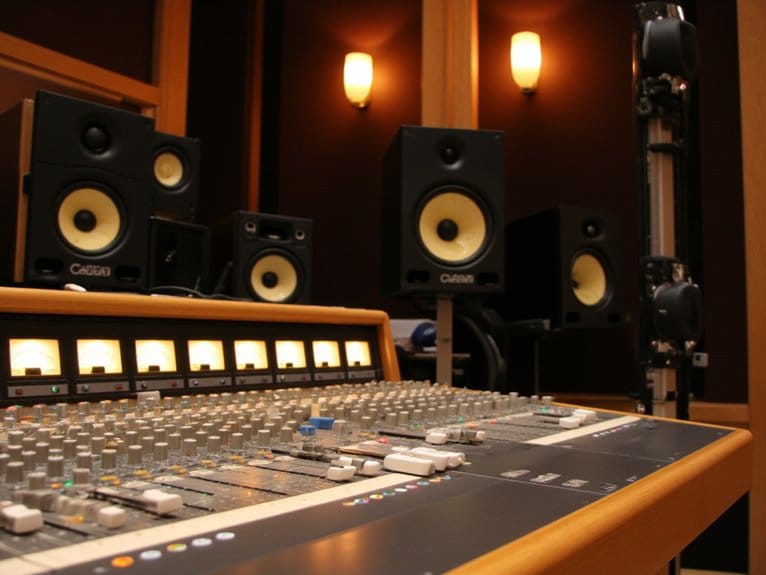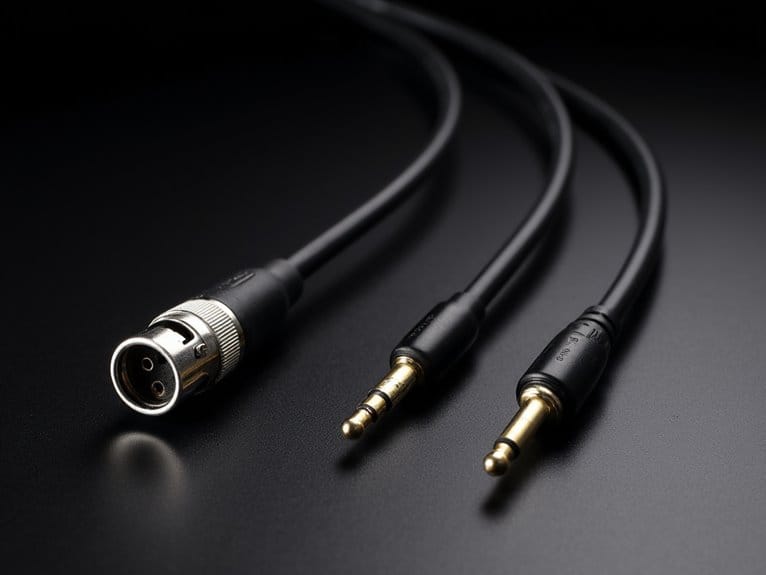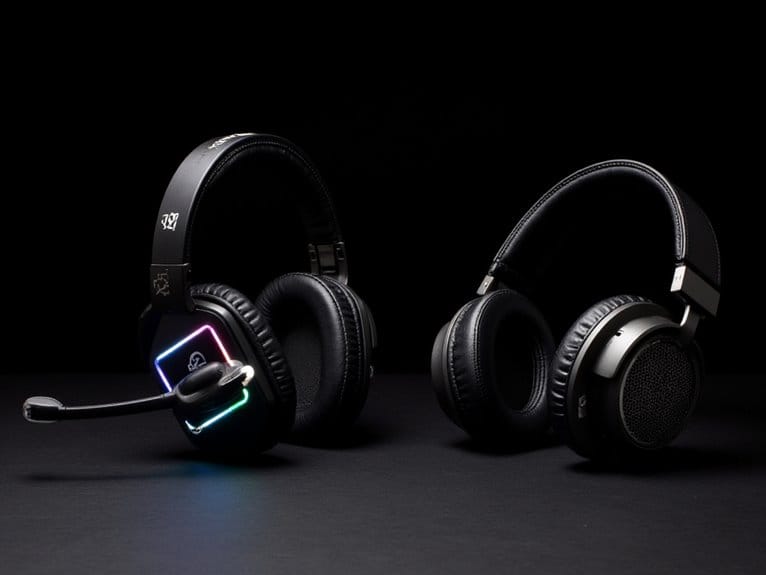Audio Interface Buyer’s Guide: Everything You Need to Know
You’ll need to take into account several key factors when choosing an audio interface: bit depth and sampling rates (24-bit/192kHz for professional quality), input/output configurations matching your recording needs, connection types like USB 3.0 or Thunderbolt for low latency, and built-in preamps with zero-latency monitoring capabilities. Popular options range from budget-friendly Behringer models under $100 to professional Universal Audio units exceeding $1,000, with brands like Focusrite Scarlett offering reliable middle-ground solutions that include quality converters and bundled software to maximize your investment value.
We are supported by our audience. When you purchase through links on our site, we may earn an affiliate commission, at no extra cost for you. Learn more.
Notable Insights
- Audio interfaces convert analog sound to digital for computer recording and include built-in preamps for input management.
- Choose 24-bit resolution and appropriate sampling rates (48-192kHz) based on your quality needs and CPU capabilities.
- Consider input/output configuration (XLR, TRS, instrument) and digital expansion options like ADAT for future growth.
- Select connection type (USB 2.0/3.0, Thunderbolt, FireWire) based on latency requirements and computer compatibility.
- Budget ranges from under $100 entry-level to $1,500+ professional models, with quality options available at every price point.
Understanding Audio Interface Basics
The gateway between your musical creativity and digital recording, an audio interface serves as the vital bridge that transforms analog sound waves from your instruments and microphones into the digital language your computer understands.
Through sophisticated audio signal processing, these devices handle the essential analog-to-digital conversion that makes home recording possible, while simultaneously converting digital audio back to analog for monitoring through your speakers or headphones.
When evaluating interface design considerations, you’ll find that most units include built-in preamps for amplifying microphone signals, gain controls for ideal input levels, and various output options for flexible monitoring setups.
The quality of these components directly impacts your recordings’ clarity and character, making your interface choice a fundamental decision that’ll influence every project you create in your digital audio workstation. Many professional interfaces also feature zero-latency monitoring to ensure you can record in real-time without any distracting delays.
Professional interfaces deliver 24-bit recording capabilities for studio-grade audio quality that far exceeds the performance of built-in computer sound cards.
Resolution and Sampling Rate Specifications
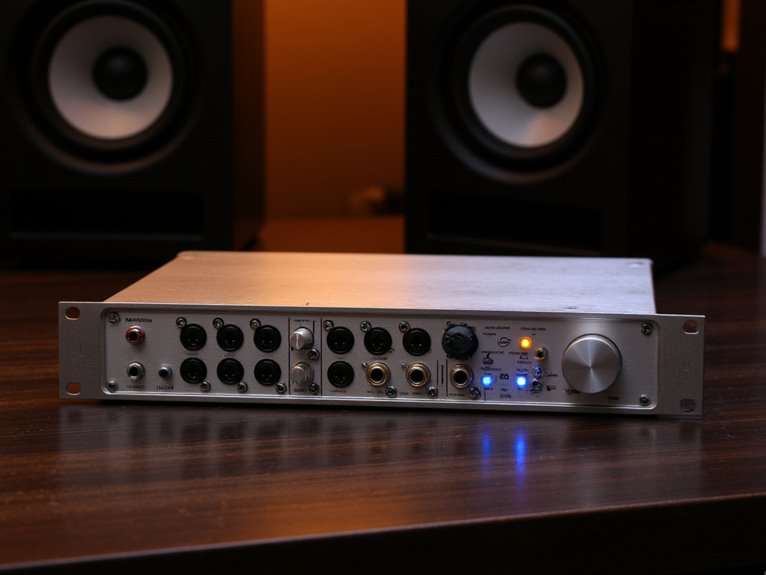
Resolution specifications form the technical backbone of every audio interface decision you’ll make, and honestly, I’ve seen too many producers get overwhelmed by the numbers without understanding what they actually mean for their recordings.
Your bit depth choices-16-bit, 24-bit, or 32-bit-directly impact dynamic range and signal-to-noise ratio, with each additional bit providing approximately 6 dB more headroom for cleaner captures.
Sample rate trade offs become critical when balancing audio quality against system performance, as 96 kHz recordings demand considerably more CPU power than 48 kHz alternatives.
The resolution benefits of higher specifications shine brightest in acoustic recordings and mastering scenarios, where capturing subtle harmonics and spatial information makes the difference between amateur and professional results.
Most professional audio interfaces support 24-bit/192kHz resolution for superior audio fidelity, providing the technical foundation for broadcast-quality recordings.
Interfaces with switchable Air mode can enhance certain recordings by brightening the sound characteristics, particularly beneficial when working with dynamic microphones that require additional frequency response adjustments.
Input and Output Configuration Options
When you’re selecting an audio interface, input and output configurations will make or break your studio workflow, and I’ve watched countless producers realize too late that their interface can’t handle their actual recording needs.
Input types like XLR for mics, TRS for line instruments, and dedicated instrument inputs for guitars determine your recording versatility, while output types including monitor feeds and headphone connections shape your monitoring preferences.
Your interface’s input and output types directly dictate which instruments you can record and how you’ll monitor your sessions.
Channel configurations range from basic 2-in/2-out setups to multi channel setups supporting 16+ simultaneous inputs, with signal balancing reducing noise on longer runs.
Don’t overlook MIDI usage for legacy gear integration, and consider connection versatility through ADAT optical expansion when planning future studio growth.
Count all microphones and instruments for simultaneous recording and add 20-30% extra inputs for future expansion to avoid costly upgrades down the line. Dedicated headphone outputs provide zero-latency monitoring which is crucial for maintaining performance quality during live recording sessions.
Connection Types and Data Transfer Methods
Four distinct connection types dominate today’s audio interface landscape, and I’ve seen too many home producers get stuck with interfaces that can’t grow with their ambitions simply because they didn’t understand the real-world implications of USB 2.0 versus Thunderbolt bandwidth.
USB benefits include bus-powered operation and broad compatibility, with USB 3.0 handling over 100 channels simultaneously, while Thunderbolt advantages encompass ultra-low latency and several hundred channel capacity for professional workflows. Modern interfaces with USB-C connectivity increase usability with contemporary devices including tablets and laptops.
FireWire decline reflects its obsolescence despite once-reliable performance, as modern computers lack compatible ports. Your data transfer needs determine whether you’ll experience dropouts during intensive sessions, and power sourcing considerations affect portability versus performance capabilities.
Driver compatibility varies greatly between connection types, particularly impacting Thunderbolt interfaces requiring proprietary software optimization. Thunderbolt’s PCIe architecture reduces CPU load during intensive recording sessions, delivering superior performance compared to traditional USB connections.
MIDI Integration and Compatibility Features
Although many producers overlook MIDI capabilities when choosing audio interfaces, I’ve learned through countless studio sessions that proper MIDI integration can make or break your creative workflow, especially when you’re juggling multiple hardware synthesizers, drum machines, and controllers in complex arrangements.
Models like the SSL 2+ MKII and Focusrite Scarlett 18i20 4th Gen include dedicated MIDI In/Out ports, enabling seamless MIDI device synchronization across your entire setup. The MIDI protocol advantages become evident when you’re triggering program changes, sending CC messages, and maintaining precise timing between multiple devices without relying on USB connections that can introduce latency. Unlike standard sound cards that focus primarily on basic audio playback, audio interfaces provide the robust MIDI connectivity essential for professional multi-device setups. When selecting an interface, ensure that MIDI connectivity capabilities align with your hardware setup requirements to avoid workflow limitations.
- Watch your creative momentum build as devices respond instantly to your commands
- Feel the satisfaction of perfectly synchronized sequences across all hardware
- Experience seamless workflow shifts between software and hardware instruments
- Enjoy the reliability of dedicated MIDI ports during critical recording sessions
- Appreciate the reduced cable clutter compared to multiple USB MIDI adapters
Budget Considerations and Price Ranges
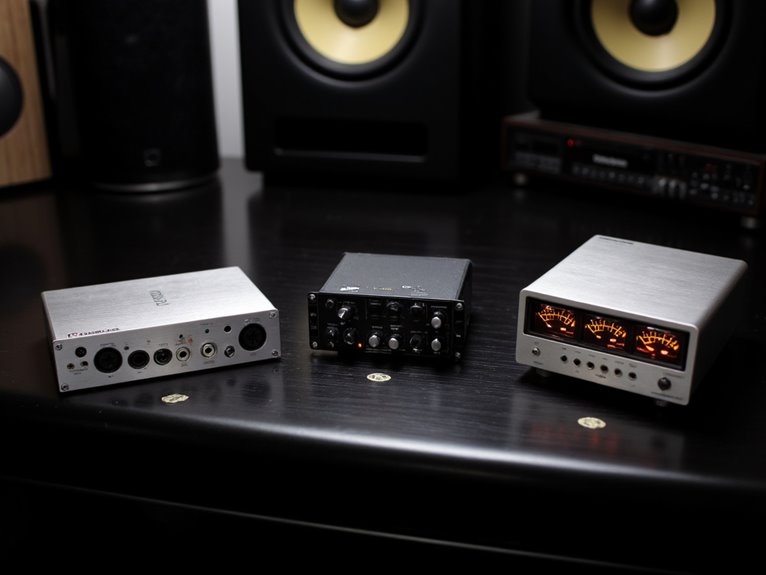
When you’re shopping for an audio interface, you’ll find yourself maneuvering a surprisingly wide price spectrum that ranges from budget-friendly entry-level options under $100 to professional high-end models that can easily exceed $1,000.
Honestly, the difference in features and quality can be pretty dramatic. Your choice between these two extremes will largely depend on your specific recording needs, experience level, and how much you’re willing to invest in audio quality, input flexibility, and advanced features like high-resolution conversion or professional-grade preamps.
I’ve found that understanding what separates a basic interface from a premium model helps you make a more informed decision about where to allocate your budget for the best possible recording experience. Budget-friendly options can deliver professional results under $1000, proving that expensive models often offer enhanced features but may be unnecessary for solo musicians.
For budget-conscious users, affordable interfaces priced between $70-$150 can deliver studio-quality results that rival more expensive options, making professional recording accessible without breaking the bank.
Entry-Level Budget Options
If you’re just starting your audio recording journey or working with a tight budget, entry-level audio interfaces between $50 and $100 offer surprisingly capable performance that’ll get you recording without breaking the bank.
Budget friendly brands like Behringer and M-Audio deliver essential user features including two inputs, USB connectivity, and adequate preamps for casual recording, while Focusrite and PreSonus provide slightly more refined options with robust software bundles that enhance your recording experience.
Many entry-level interfaces like the Behringer U-PHORIA UMC404HD deliver impressive 24-bit/192kHz recording capabilities that rival more expensive units. The Behringer UMC22 offers a budget-friendly option with Midas-designed preamp and direct monitoring capabilities for home recordings and podcasting.
- Start creating music today without waiting months to save for expensive gear
- Transform your bedroom into a legitimate home studio for less than a weekend dinner out
- Finally record those song ideas before they slip away forever
- Join thousands of successful musicians who started with budget equipment
- Stop making excuses and begin your musical legacy
Professional High-End Models
Once you’ve mastered the basics with entry-level gear and begun taking your recording seriously, professional high-end audio interfaces represent a significant leap in both capability and investment, typically starting around $500 and extending well beyond $1,500 for flagship models.
These units deliver exceptional preamps, low-latency performance, and superior analog-to-digital conversion that’ll make your recordings shine with studio-grade clarity. Professional features include expandability through ADAT support, DSP integration, and advanced software ecosystems like Universal Audio’s LUNA platform.
Connectivity options expand dramatically, with Thunderbolt 3/4 interfaces like the Apollo Twin X offering lightning-fast data transfer, multiple simultaneous inputs, and robust metal chassis construction.
Models from Universal Audio, Neve, and SSL provide the professional-grade circuitry and networking capabilities serious producers demand.
Preamp Quality and Signal Processing
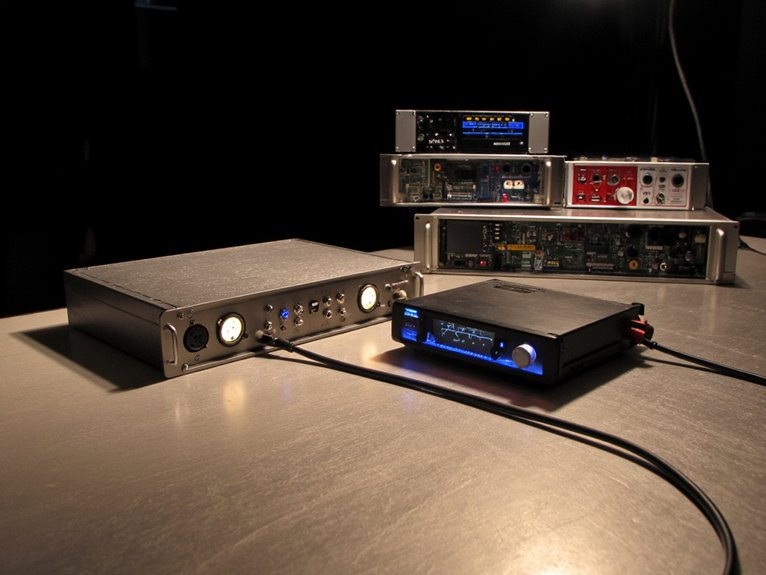
Why does preamp quality matter so much when you’re choosing an audio interface? The preamp serves as your signal’s first point of contact, determining whether your recordings capture professional clarity or suffer from unwanted noise and distortion.
Quality preamps provide transparent amplification with minimal preamp coloration effects, while inferior ones introduce artifacts that compromise your audio. Signal boosting techniques vary greatly between solid-state, tube, and hybrid designs, each offering distinct sonic characteristics that affect your final recordings.
Consider these essential preamp factors when making your selection:
- Noise floor performance – Lower noise means cleaner recordings at higher gain settings
- Frequency response linearity – Flat response guarantees accurate sound reproduction across all frequencies
- Gain range flexibility – Adequate headroom accommodates various microphones and input levels
- Distortion characteristics – Minimal THD preserves signal integrity throughout the recording chain
- External preamp compatibility – Integration options for future upgrades and expanded capabilities
The quality of preamps directly impacts recording dynamics and final mix stability, with expensive preamps providing measurably better quality through lower noise floors and greater gain headroom compared to built-in interface preamps. Professional-grade preamps can deliver exceptional performance with 72dB gain capability, making them ideal for demanding dynamic microphones that require substantial amplification.
Latency Performance and Real-Time Monitoring
After you’ve secured excellent preamp performance for your recordings, you’ll quickly discover that even the cleanest signal becomes frustrating if you can’t monitor it properly during performance. Latency optimization techniques become essential when you’re tracking vocals or instruments, where even slight delays can throw off your timing and feel.
Your monitoring workflow strategies depend heavily on buffer size settings and driver quality, with ASIO drivers on Windows and Core Audio on Mac providing the foundation for low-latency operation. Smaller buffer sizes reduce roundtrip latency but demand more CPU power, while hardware direct monitoring bypasses computer processing entirely for zero-latency tracking. Professional audio interfaces supporting 24-bit/192kHz resolution deliver superior digital conversion quality that maximizes your recording potential in DAW environments. Calculating latency involves dividing your buffer size by the sample rate, which means 128 samples at 44.1kHz produces roughly 2.9ms of delay.
| Interface Type | Typical RTL Performance |
|---|---|
| USB (Optimized) | 6-8ms at low buffers |
| Thunderbolt | 7-10ms (driver dependent) |
| Hardware Direct | 0ms (analog path) |
Digital Expansion Capabilities
When you’re evaluating audio interfaces, you’ll want to look beyond the built-in analog inputs and outputs to examine digital expansion capabilities, which can dramatically increase your recording capacity without forcing you to upgrade your entire setup.
ADAT optical ports, the most common expansion format, let you connect external preamps or converters that add eight channels at standard sample rates, while S/PDIF provides stereo digital connectivity for specific gear like outboard processors or digital mixers.
I’ve found that interfaces with these digital expansion options offer the most flexible upgrade paths, allowing you to start with a basic unit and gradually build a larger system as your studio needs grow. Unlike analog mixers that require physical hardware additions for expanded routing, digital expansion through your interface maintains consistent signal quality throughout your extended setup.
Keep in mind that when expanding digitally, maintaining consistent sample rates across all connected devices prevents conversion artifacts that can degrade your overall audio quality.
ADAT and S/PDIF Ports
The digital expansion capabilities of modern audio interfaces have revolutionized how we scale recording setups.
I’ve found that ADAT and S/PDIF ports represent some of the most cost-effective ways to dramatically increase your channel count without buying an entirely new interface.
Standard ADAT channeling delivers eight channels of 24-bit audio at 48 kHz through optical Lightpipe connections, while dual inputs can provide sixteen channels total.
S/PDIF synchronization handles stereo digital signals via coaxial or optical cables, perfectly complementing ADAT expansion.
Higher sample rates reduce channel count through S/MUX technology, dropping to four channels at 96 kHz.
- Transform your home studio into a professional recording facility overnight
- Record entire bands simultaneously without compromise or channel limitations
- Maintain pristine digital signal paths with sub-1ns jitter performance
- Scale your setup affordably using external preamps and converters
- Future-proof your investment with flexible expansion possibilities
Expandable Input/Output Options
While ADAT and S/PDIF connections provide excellent starting points for digital expansion, I’ve discovered that modern audio interfaces offer far more sophisticated scaling solutions through Thunderbolt modules, MADI networking, and emerging audio-over-IP protocols that can transform modest setups into professional-grade recording environments.
Thunderbolt advantages include ultra-low latency and daisy-chaining capabilities, while USB versatility offers plug-and-play compatibility across systems. MADI applications excel in broadcast environments, supporting 64 channels per cable, and Dante integration enables hundreds of networked channels with MIDI expansion possibilities.
| Technology | Channel Count | Best Use Case | Connection Type |
|---|---|---|---|
| Thunderbolt/USB | Variable | Home Studios | Digital Cable |
| MADI | 64 Channels | Live Sound | Coaxial/Fiber |
| Dante | 500+ Channels | Large Facilities | Ethernet |
| AES/EBU | 2 Per Port | Professional Gear | Balanced XLR |
Top Brands and Popular Model Comparisons
Five major brands dominate today’s audio interface market, each carving out distinct niches that cater to different user needs and budgets.
Focusrite’s Scarlett series leads home studios with reliable preamps and extensive software bundles, while MOTU’s M2 and M4 models deliver exceptional 2.5ms latency performance that rivals professional gear.
Universal Audio’s Volt series brings vintage-inspired character to podcasters and home recordists, and Audient’s iD4 MkII provides beginner-friendly transparency at competitive pricing.
Behringer’s UMC22 surprises with MIDAS preamps at budget-friendly costs.
- Focusrite Scarlett 2i2: Your reliable workhorse that won’t let you down
- MOTU M4: The latency champion that keeps you in perfect sync
- Universal Audio Volt 2: Your gateway to professional vintage sound
- Audient iD4 MkII: The confidence-boosting choice for newcomers
- Behringer UMC22: Proof that quality doesn’t require breaking the bank
Software Compatibility and Bundled Applications
When you’re evaluating audio interfaces, the software that comes bundled with your hardware can greatly impact your overall investment value, though the quality and usefulness of these packages varies dramatically between manufacturers and price points.
You’ll need to carefully assess whether the included DAW, plugin suite, or virtual instruments actually meet your production needs, or if they’re simply entry-level versions that’ll require expensive upgrades down the line.
I’ve seen countless musicians get swayed by impressive-sounding software bundles, only to discover later that compatibility issues with their preferred operating system, or limitations within the bundled applications themselves, forced them to purchase additional software anyway.
DAW Integration Requirements
Before you fall in love with that sleek audio interface sitting in your shopping cart, I need to share something that’ll save you hours of frustration: your dream recording setup means absolutely nothing if your DAW can’t talk to your hardware.
DAW requirements vary considerably between platforms, with macOS relying on Core Audio while Windows demands ASIO drivers for ideal interface latency. Plugin compatibility becomes vital when you’re investing in VST3, AU, or AAX formats across different systems.
- Your expensive interface becomes a paperweight without proper driver updates
- OS optimization determines whether you’ll create music or troubleshoot crashes
- System performance requirements can make or break your recording sessions
- Interface latency issues will destroy your creative flow instantly
- Plugin compatibility problems waste precious studio time
Bundled Software Value
The smartest audio interface manufacturers understand that hardware alone doesn’t create music, which explains why they’re stuffing their packages with software bundles that can easily double or triple your investment’s actual value.
These carefully curated software collections typically include entry-level DAWs, virtual instruments, and effects plugins that enable immediate music production without additional purchases, effectively meeting customer expectations for extensive creative tools.
Focusrite’s Scarlett series exemplifies this approach by bundling Pro Tools First and Ableton Live Lite, while Native Instruments raises the bar with their Komplete Start suite, delivering exceptional value through seamless software integration.
However, budget-focused brands like Behringer prioritize hardware affordability over bundled software, forcing you to weigh immediate savings against long-term software acquisition costs when making your purchasing decision.
Performance Metrics and Testing Standards
While shopping for an audio interface can feel overwhelming with all the technical jargon thrown around, I’ve found that understanding key performance metrics makes the difference between buying something that’ll genuinely improve your recordings and falling for marketing hype.
The performance metrics and testing standards that actually matter include signal-to-noise ratio, dynamic range, frequency response, and latency measurements. Premium interfaces achieve A-weighted dynamic ranges exceeding 120dB, while affordable options typically deliver 116-119dB-still excellent by most standards.
- Feel confident knowing your recordings capture every subtle detail
- Experience the clarity that separates amateur from professional sound
- Eliminate frustrating noise and distortion from your creative process
- Achieve the pristine audio quality your music deserves
- Trust specifications backed by rigorous testing standards
Future-Proofing Your Audio Interface Investment
Beyond performance specifications that validate your interface’s current capabilities, I’ve learned that smart purchasing decisions require evaluating how well your investment will adapt to tomorrow’s studio requirements, software updates, and evolving production workflows.
When I’m advising clients on future-proofing strategies, I emphasize interfaces featuring modular design systems that allow component upgrades without complete replacement, wireless connectivity options for flexible studio configurations, and AI integration capabilities that enhance real-time processing workflows.
Build quality remains paramount since robust construction protects your investment through years of technological evolution, while support for emerging standards like USB-C, Thunderbolt, and spatial audio protocols guarantees compatibility with next-generation software and hardware developments that’ll inevitably reshape professional audio production environments.
Frequently Asked Questions
Can I Use Multiple Audio Interfaces Simultaneously on One Computer?
Yes, you can run multiple audio interfaces simultaneously, though audio interface compatibility varies greatly between operating systems.
Multiple interface setups work best on macOS through native aggregate device support, while Windows requires workarounds like ASIO4ALL that aren’t perfect.
I’ve found success combining interfaces from the same manufacturer, which often provide dedicated multi-device drivers, or using hardware synchronization via ADAT connections for professional results.
How Do I Troubleshoot Crackling or Popping Sounds From My Interface?
For audio troubleshooting, I’d start by checking your cables since they’re usually the culprit-wiggle connections while playing audio to identify loose spots.
Next, increase your buffer size in interface settings, which often resolves crackling immediately.
Disable USB power management in Windows, close background applications consuming CPU resources, and guarantee your sample rates match between your DAW and interface driver software.
What’s the Difference Between Balanced and Unbalanced Audio Interface Connections?
Balanced connections use three conductors-hot, cold, and ground-sending two opposing signal copies that cancel noise at the receiving end, while unbalanced connections rely on single signal wire plus ground, making them susceptible to interference.
You’ll find balanced outputs excel over long cable runs with superior noise immunity, whereas unbalanced connections work fine for short distances but pick up hum and buzzing beyond ten feet in most setups.
Do Audio Interfaces Work With Smartphones and Tablets for Mobile Recording?
Yes, most modern audio interfaces work with smartphones and tablets through USB-C connections, though interface compatibility varies by device and manufacturer.
You’ll need USB class compliant interfaces for plug-and-play functionality, and I’ve found that newer models like the iConnectivity AUDIO4c offer designed mobile recording compatibility.
However, some flagship phones still experience audio glitches, so checking specific device compatibility before purchasing remains essential for reliable mobile recording.
How Often Should I Update My Audio Interface Drivers and Firmware?
You should check for driver maintenance and firmware updates monthly or quarterly, depending on your workflow demands.
I’ve found that manufacturers release updates irregularly, sometimes monthly, sometimes seasonally, so consistent checking prevents compatibility issues with your DAW or operating system.
Schedule firmware updates during downtime since they can disrupt sessions, and always backup your current settings before installing anything new to avoid headaches later.
On a final note
You’ve now got the foundation to choose an audio interface that’ll serve your creative goals without breaking the bank or becoming obsolete next year. I’ve covered the technical specs, connectivity options, and compatibility factors that matter most, though admittedly there’s always more to learn in this rapidly evolving field. Trust your specific needs over flashy features, and you’ll find the right interface for your studio.

